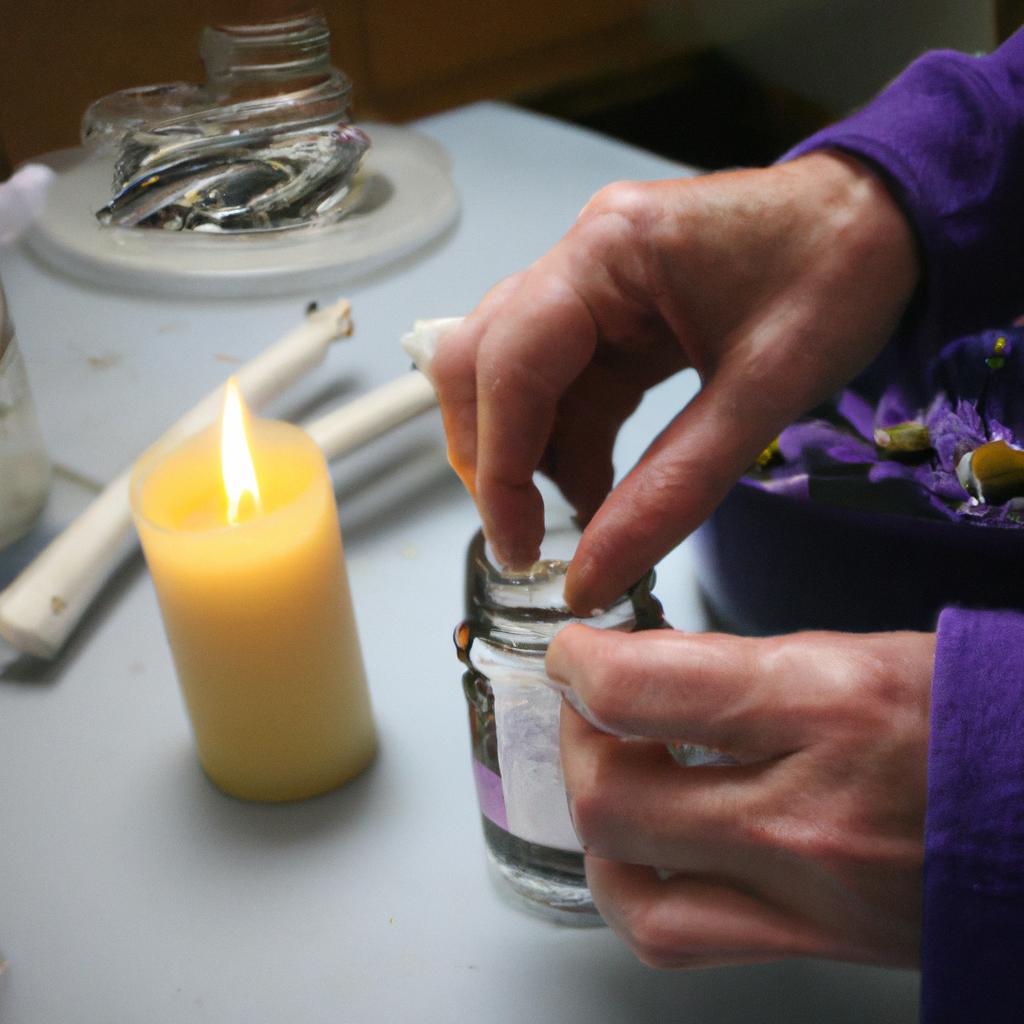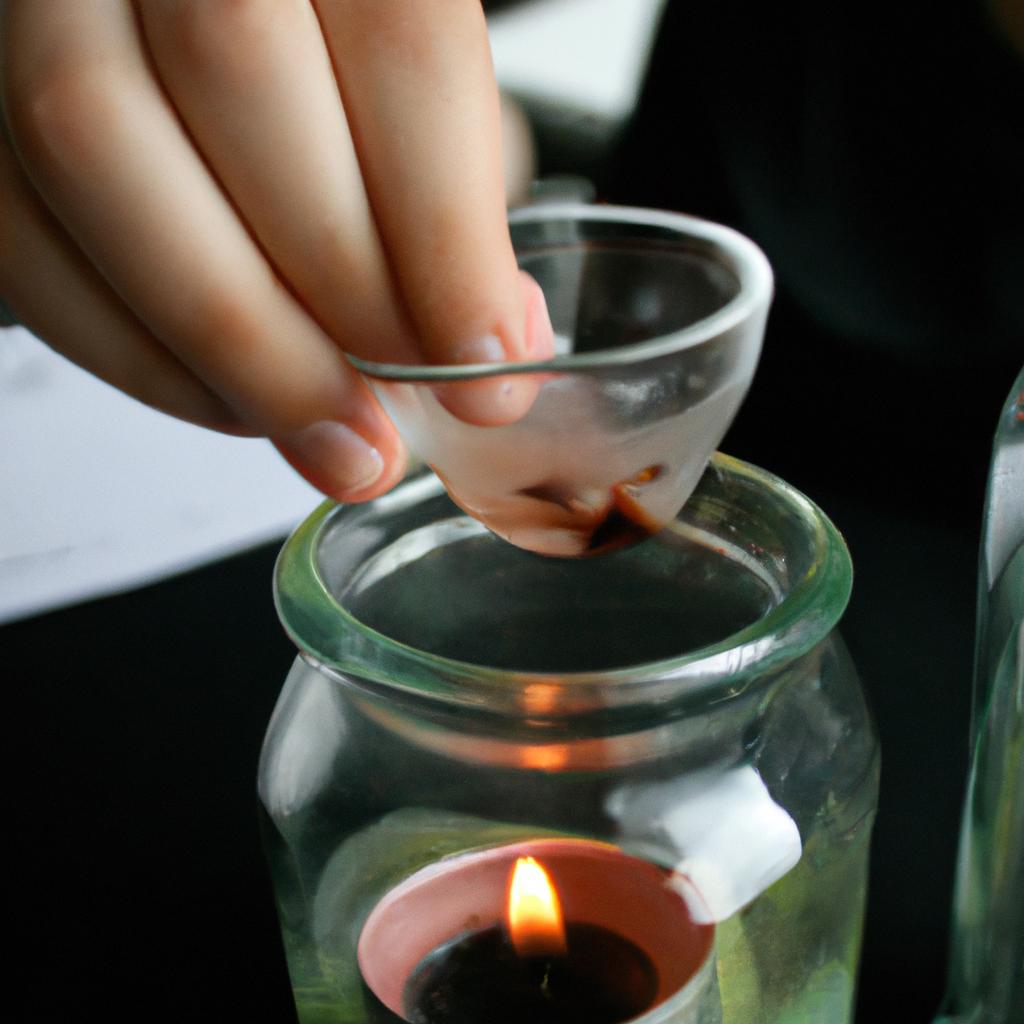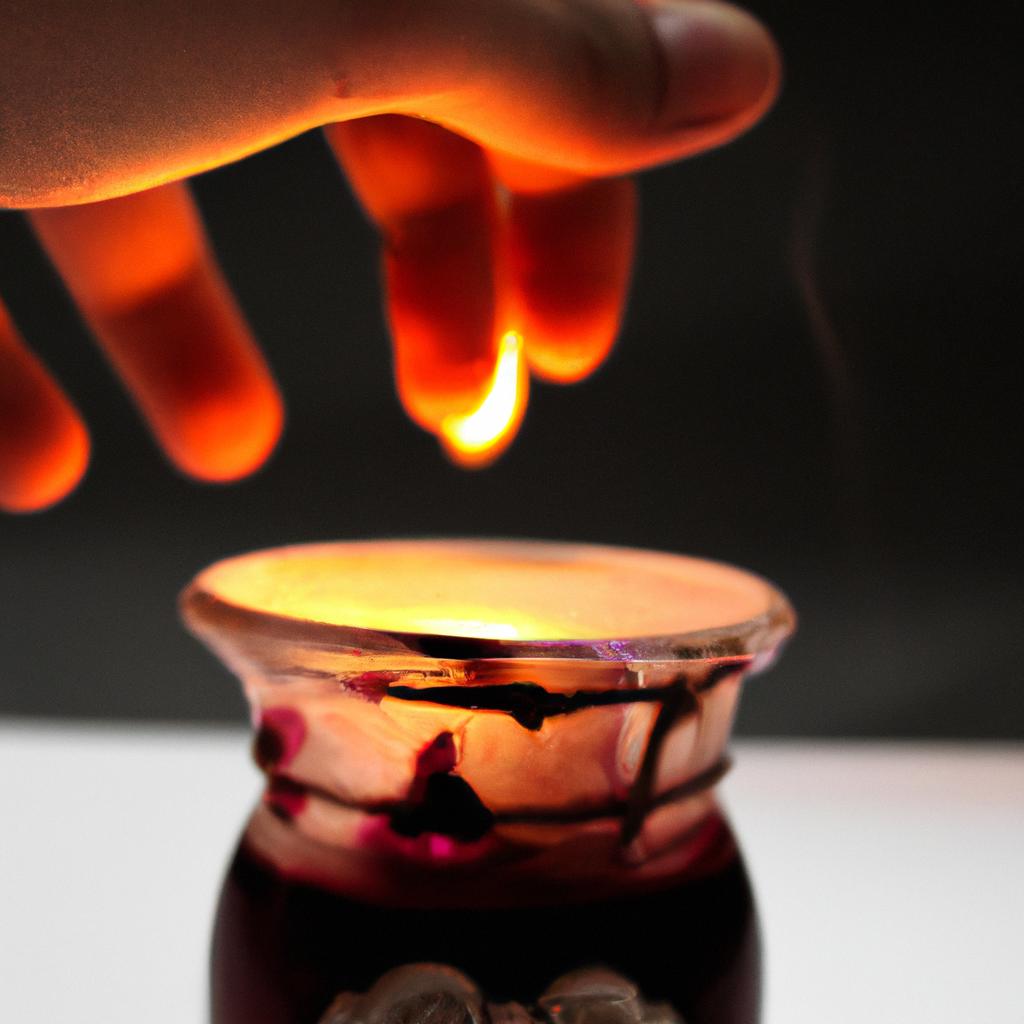Choosing the Right Candle Fragrance: A Guide to Candle Making

In recent years, the popularity of candle making has surged as individuals seek to create personalized and aromatic additions to their homes. However, amidst the vast array of candle fragrances available on the market, choosing the right one can be a daunting task. This guide aims to provide clarity by offering valuable insights into the process of selecting the ideal fragrance for your homemade candles.
Imagine walking into a cozy living room adorned with flickering candles that exude a captivating aroma. The scent immediately transports you back to childhood memories of baking cookies with your grandmother during holidays; it evokes feelings of warmth, comfort, and nostalgia. This scenario exemplifies the power and significance of choosing the right candle fragrance – it sets the mood, creates ambiance, and enhances overall well-being within an environment.
To navigate this olfactory journey effectively, one must consider various factors such as personal preferences, desired effects, and compatibility with different spaces. By understanding these key elements and exploring different fragrance families and notes, candle makers can craft scents that not only appeal to their own taste but also resonate with those who experience them. As we embark on this exploration together, let us delve deeper into the artistry behind selecting the perfect candle fragrance: an endeavor that combines science, creativity, and sensory experiences to create a truly captivating and harmonious ambiance.
When it comes to personal preferences, each individual has unique scent preferences and associations. Some may gravitate towards floral fragrances, finding them uplifting and refreshing, while others may prefer warm and cozy scents like vanilla or cinnamon. Consider your own scent memories and the emotions they evoke. Do you want your candle to promote relaxation, energize your space, or create a romantic atmosphere? Identifying the desired effect will guide you in selecting the right fragrance.
Compatibility with different spaces is another crucial aspect to consider. Certain scents work better in specific areas of the home. For example, fresh and citrusy fragrances tend to be more suitable for kitchens and bathrooms where a clean and invigorating aroma is desired. On the other hand, soothing scents like lavender or chamomile are often preferred in bedrooms or meditation spaces to promote tranquility. Keep in mind the purpose of each room when choosing your candle fragrance.
To better understand fragrance families and notes, let’s explore some common categories:
-
Floral: These fragrances feature notes from flowers such as rose, jasmine, or lily. They can range from delicate and feminine to bold and intoxicating.
-
Fruity: Think of vibrant scents like apple, peach, or tropical fruits that add a playful touch to any space.
-
Woody: Fragrances with woody notes like cedarwood or sandalwood create an earthy and grounding ambiance reminiscent of a forest retreat.
-
Gourmand: These scents mimic food aromas like vanilla, chocolate, or caramel—perfect for creating a cozy atmosphere that reminds us of our favorite treats.
-
Fresh: Clean and crisp scents such as citrus or oceanic notes bring a sense of freshness into any room.
Remember that fragrances can also be blended together to create unique combinations tailored to your preferences. Experimentation is encouraged!
In conclusion, selecting the ideal fragrance for your homemade candles involves a thoughtful consideration of personal preferences, desired effects, and compatibility with different spaces. By understanding fragrance families and notes, you can embark on an olfactory journey that brings joy, relaxation, or any other emotions you desire within your home. Happy candle making!
Understanding the Importance of Scent in Candle Making
Imagine walking into a room filled with the warm and inviting aroma of vanilla. Instantly, you feel relaxed, your mood uplifted, and a sense of comfort washes over you. This is the power of scent, and it plays a key role in candle making. The fragrance that emanates from a burning candle can have a profound impact on our emotions, creating an atmosphere that enhances our overall well-being.
To fully comprehend the significance of scent in candle making, let us delve deeper into its effects. First and foremost, scented candles add an extra dimension to our homes or any space they inhabit. They have the ability to create ambience and evoke specific moods depending on their fragrances—whether it’s the calming effect of lavender for relaxation or the energizing essence of citrus for invigoration.
In addition to setting a desired ambiance, scented candles also possess inherent therapeutic qualities. Certain fragrances can relieve stress, promote better sleep quality, or even enhance focus and concentration. For example, consider using eucalyptus-scented candles during meditation sessions to encourage deep breathing and relaxation.
To further understand how different scents affect us emotionally and psychologically within candle making practices, we can examine some key examples:
- Lavender: Known for its calming properties; ideal for promoting relaxation before bedtime.
- Citrus: Uplifting and refreshing; perfect for boosting energy levels during daytime activities.
- Vanilla: Comforting and soothing; creates a cozy atmosphere that promotes feelings of warmth.
- Sandalwood: Earthy and grounding; aids in reducing anxiety while fostering mental clarity.
Furthermore, by incorporating various scents into candle making through essential oils or natural fragrance extracts, candle enthusiasts are provided with endless possibilities to cater to individual preferences. It allows them to curate experiences unique to themselves or others based on personal tastes or occasions.
As we continue exploring this guide to candle making, we will now move on to the next section: Identifying Different Types of Candle Fragrances. By understanding the importance of scent and its impact on our emotions, we can then delve into selecting the appropriate fragrances for our candles, ensuring a truly captivating sensory experience.
Note: The bullet point list below provides an example of how different scents can evoke emotional responses:
- Lavender – Relaxation
- Citrus – Energy
- Vanilla – Comfort
- Sandalwood – Grounding
The table below illustrates some common fragrance types along with their associated benefits:
| Fragrance Type | Benefits |
|---|---|
| Floral | Uplifts mood, promotes relaxation |
| Fresh | Energizes, enhances focus |
| Fruity | Invigorates, stimulates creativity |
| Herbal | Calms nerves, aids in stress relief |
Now that we have examined the significance of scent in candle making and explored various examples and effects, let us proceed to identify different types of candle fragrances.
Identifying Different Types of Candle Fragrances
Now, let’s delve deeper into identifying different types of candle fragrances that can add a touch of magic to your creations. To illustrate this further, imagine you are crafting candles for a cozy winter-themed event. You want your candles to evoke feelings of warmth and comfort as guests enter the venue.
When selecting the right fragrance for your candles, consider the following factors:
- Intensity: Determine whether you prefer a subtle or strong fragrance. Some scents may be overpowering in small spaces, while others create an inviting atmosphere even with just a hint of aroma.
- Seasonality: Consider choosing fragrances that complement each season. For example, floral scents may work well during springtime, while warm spice aromas could be ideal for autumn.
- Personal Preferences: Take into account your own preferences and those of your target audience. Different people have varying tastes when it comes to scents, so aim to select fragrances that will appeal to a wide range of individuals.
- Theme or Purpose: Align the fragrance with the theme or purpose of your candles. If you are creating candles for relaxation purposes, soothing scents like lavender or chamomile might be suitable.
| Fragrance | Mood | Ambiance |
|---|---|---|
| Vanilla | Calming | Cozy |
| Citrus | Uplifting | Refreshing |
| Sandalwood | Grounding | Serene |
| Cinnamon | Invigorating | Festive |
By carefully considering these factors and utilizing them as guiding principles throughout your decision-making process, you can ensure that every candle you make has a unique and captivating fragrance. In the subsequent section, we will discuss how to consider the desired mood and ambiance when selecting candle fragrances, allowing you to create an immersive experience for your customers or guests.
Considering the Desired Mood and Ambience
Transitioning from the previous section on identifying different types of candle fragrances, let’s now delve into an important consideration when choosing the right fragrance for your candles: considering the desired mood and ambience. To illustrate this concept, imagine you are hosting a cozy dinner party at home. You want to create a warm and inviting atmosphere that will make your guests feel relaxed and comfortable.
When selecting a candle fragrance for such an occasion, it is crucial to consider the specific mood or ambiance you wish to evoke. Here is an example scenario: picture yourself setting up a beautifully decorated dining table with soft lighting, elegant dinnerware, and fresh flowers as centerpieces. You decide to use scented candles to enhance the overall sensory experience for your guests.
To guide you in making informed choices about candle fragrances, here are some factors to consider:
- Scent notes: Different fragrances have varying scent profiles composed of top, middle, and base notes. These notes can range from floral and fruity to woody or spicy. Consider which scent combinations align with your desired atmosphere.
- Intensity level: Some individuals prefer subtle scents that provide a delicate background aroma, while others enjoy stronger fragrances that fill the entire space more prominently. Determine what intensity level best suits your intended ambiance.
- Seasonal considerations: Certain fragrances may be more appropriate during specific seasons. For instance, citrusy or tropical scents might be refreshing during summer months, whereas warm vanilla or cinnamon aromas may be comforting during colder seasons.
- Personal preferences: Ultimately, remember that personal preference plays a significant role in selecting candle fragrances. What scents resonate with you? Which ones bring back fond memories or create a sense of calm? Trust your instincts when making these choices.
Consider using the following table as a reference point when brainstorming ideas for different moods and corresponding candle fragrances:
| Mood | Fragrance Suggestions |
|---|---|
| Relaxation | Lavender, Chamomile, Sandalwood |
| Energy | Citrus (e.g., Lemon, Orange), Peppermint |
| Romance | Rose, Jasmine, Ylang-Ylang |
| Festivity | Pine, Cinnamon, Cranberry |
In conclusion to this section on considering the desired mood and ambience when choosing candle fragrances, remember that scent has a powerful effect on our emotions. By carefully selecting appropriate fragrances for different occasions and settings, you can create an atmosphere that enhances the overall experience for yourself and your guests. In the subsequent section about exploring popular candle fragrance families, we will further explore various fragrance categories and their unique characteristics.
Exploring the Popular Candle Fragrance Families
To create the perfect atmosphere, it is crucial to select a candle fragrance that aligns with the desired mood and ambience. Whether you are aiming for relaxation, romance, or rejuvenation, the scent of your candles plays a significant role in setting the tone. For instance, imagine wanting to create a cozy and warm ambiance in your living room during winter evenings. In this scenario, choosing a fragrance like “Spiced Cider” would be ideal as it combines elements of cinnamon, apple, and cloves to evoke feelings of comfort and nostalgia.
When selecting a candle fragrance, keep in mind the following factors:
- Scent Intensity: Consider whether you prefer a subtle aroma or a more pronounced scent that fills the entire space.
- Seasonal Appeal: Different fragrances can enhance specific seasons or occasions. Opting for fresh florals in spring or festive spices during the holiday season adds an extra touch to your environment.
- Personal Preferences: Everyone’s olfactory preferences differ. What may be pleasing to one person might not resonate with another. It is essential to choose scents that personally appeal to you and make you feel comfortable.
- Complementary Notes: Pay attention to how different notes interact with each other. Combining scents from similar fragrance families can create harmonious blends that elevate the overall experience.
To help illustrate these considerations further, let’s explore some popular fragrance families commonly used in candle making:
| Fragrance Family | Description | Associated Mood |
|---|---|---|
| Floral | Delicate and feminine scents derived from flowers | Serenity |
| Citrus | Bright and zesty aromas extracted from citrus fruits | Uplifting |
| Woody | Earthy tones reminiscent of forests and woods | Groundedness |
| Gourmand | Warm and edible fragrances such as vanilla or caramel | Comfort and indulgence |
By understanding the desired mood, considering factors such as scent intensity, seasonal appeal, personal preferences, and complementary notes, you can choose candle fragrances that create a captivating atmosphere.
Testing and Evaluating Candle Fragrances
Now that we have delved into the different candle fragrance families, it is time to understand how to effectively test and evaluate these fragrances. Testing and evaluating candle fragrances can help you make an informed decision when choosing the right scent for your candles.
To illustrate this process, let’s consider a hypothetical scenario: you are a budding candle maker who wants to create a line of soothing lavender-scented candles. Before committing to a specific fragrance oil, it is crucial to conduct thorough testing to ensure its compatibility with your vision.
When testing and evaluating candle fragrances, keep the following points in mind:
-
Vigilant Observation:
- Observe the cold throw: This refers to the scent emitted by the unlit candle.
- Pay attention to hot throw: This pertains to the aroma released while the candle burns.
- Take note of any changes in scent intensity or quality throughout burning.
-
Longevity Assessment:
- Determine how long the fragrance remains noticeable during burning.
- Consider if the scent lingers after extinguishing the flame.
- Evaluate whether it leaves behind any unpleasant residual odors.
-
Customer Feedback Collection:
- Encourage friends, family members, or potential customers to provide honest feedback on various fragrance options.
- Gather opinions on factors such as strength, appeal, and overall satisfaction.
-
Cost-Benefit Analysis:
- Compare prices and quantities offered by different suppliers.
- Assess how much of each fragrance oil is required per batch of candles.
- Calculate production costs and weigh them against projected profits.
By meticulously analyzing these aspects, you will be able to determine which fragrance best aligns with your desired outcome. Once you have completed this evaluation process, you can confidently move forward with selecting the perfect candle fragrance for your project.
Transitioning into our next section about “Selecting the Perfect Candle Fragrance for Your Project,” let us now explore how to navigate the wide range of fragrance options available in order to find the ideal scent that resonates with your creative vision.
Selecting the Perfect Candle Fragrance for Your Project
Having tested and evaluated various candle fragrances, it is now time to delve into the process of selecting the perfect fragrance that aligns with your project’s vision. To illustrate this further, let us consider a hypothetical case study where a candle maker aims to create a line of soothing candles for relaxation purposes.
When choosing the right candle fragrance for your project, there are several factors to consider. These factors will help ensure that your final product resonates with your target audience and effectively conveys the desired ambiance. Here are some key considerations:
-
Intended Atmosphere:
- Is your goal to create an invigorating or calming environment?
- Consider how different scents can evoke specific moods.
- For instance, lavender promotes relaxation, while citrus notes can uplift spirits.
-
Target Audience Preferences:
- Research and understand your target demographic preferences.
- Younger audiences may prefer fruity or floral scents.
- Older customers might lean towards more classic aromas like vanilla or sandalwood.
-
Seasonality:
- Aligning fragrances with seasonal changes can enhance customer appeal.
- Fresh florals work well in spring, while warm spices suit autumn seasons.
- Offering limited edition holiday-inspired scents can also attract attention.
-
Complementary Scents:
- Experiment with blending multiple fragrances together.
- Combining complementary scents creates unique olfactory experiences.
To better visualize these considerations, refer to the table below showcasing examples of popular scent categories alongside their associated atmospheres:
| Scent Category | Atmosphere |
|---|---|
| Floral | Serene, Romantic |
| Citrus | Energizing, Refreshing |
| Woody | Cozy, Earthy |
| Oriental | Sensual, Mysterious |
In conclusion, the process of selecting the perfect candle fragrance involves thoughtful consideration of factors such as intended atmosphere, target audience preferences, seasonality, and complementary scents. By strategically incorporating these elements into your decision-making process, you can create candles that not only smell delightful but also resonate with customers on an emotional level. Remember to experiment and explore different combinations to find your signature scent that captivates and entices.
Stay tuned for our next section where we will discuss the art of candle presentation!






